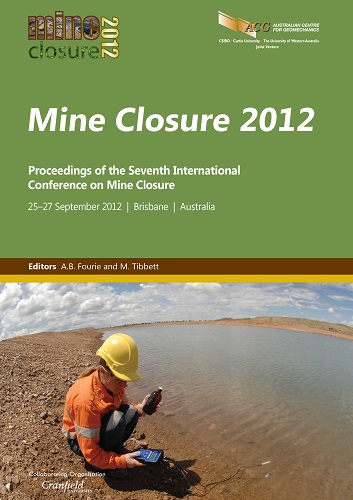Pedogenesis and soil hydraulic properties – a challenge for design and monitoring

|
Authors: Benson, CH; Albright, WH Paper is not available for download Contact Us |
DOI https://doi.org/10.36487/ACG_rep/1208_31_Albright
Cite As:
Benson, CH & Albright, WH 2012, 'Pedogenesis and soil hydraulic properties – a challenge for design and monitoring', in AB Fourie & M Tibbett (eds), Mine Closure 2012: Proceedings of the Seventh International Conference on Mine Closure, Australian Centre for Geomechanics, Perth, pp. 343-350, https://doi.org/10.36487/ACG_rep/1208_31_Albright
Abstract:
Soil hydraulic properties are required to determine the required thickness of water balance (evapotranspiration) final covers and as input to models used to predict cover performance. Saturated and unsaturated properties are typically determined on laboratory-compacted specimens and may not reflect the in-service condition following lengthy exposure to local environmental conditions. Site-specific environmental processes – freezing and thawing, wetting and drying, root growth and death, and burrowing of worms and insects – form macroscopic features and alter the hydraulic properties of the soil and the hydrology of the cover. Few data exist regarding how hydraulic properties change over time. Test sections from the Alternative Cover Assessment Program (ACAP) were exhumed four to nine years after construction to make field measurements and take specimens for laboratory analysis. Changes in hydraulic properties occurred in all cover soils evaluated, regardless of climate, cover design, or service life. Larger changes were observed for soils with lower as-built saturated hydraulic conductivity and soils with a greater proportion of clay particles in the fines fraction. Hydraulic properties of the cover soils were similar when exhumed, regardless of the as-built condition. Because changes in the engineering properties of cover materials are commonplace, and significant in some cases, monitoring of covers should be conducted to ensure they are functioning as intended. This presentation compares as-built to in-service hydraulic properties of cover soils, provides methods to estimate changes in the hydraulic properties over time, provides recommendations regarding cover construction methods that will minimise the propensity for change in hydraulic properties, and makes recommendations for monitoring. The material in this paper is taken from a much larger report – Engineered Covers for Waste Containment: Changes in Engineering Properties and Implications for Long-Term Performance Assessment (Benson et al., 2011).
References:
Albrecht, B. and Benson, C. (2001) Effect of desiccation on compacted natural clays, Journal of Geotechnical and Geoenvironmental Engineering, Vol. 127(1), pp. 67–75.
Albright, W., Benson, C., Gee, G., Abichou, T., Tyler, S. and Rock, S. (2006a) Field Performance of a Compacted Clay Landfill Final Cover at a Humid Site, Journal of Geotechnical and Geoenvironmental Engineering, Vol. 132:11, pp. 1393–1403.
Albright, W., Benson, C., Gee, G., Abichou, T., Tyler, S. and Rock, S. (2006b) Field Performance of Three Compacted Clay Landfill Covers, Vadose Zone Journal, Vol. 5, pp. 1157–1171.
Albright, W., Benson, C., Gee, G., Roesler, A., Abichou, T., Apiwantragoon, P., Lyles, B. and Rock, S. (2004) Field Water Balance of Landfill Final Covers, Journal of Environmental Quality, Vol. 33(6), pp. 2317–2332.
Albright, W.H., Benson, C.H. and Apiwantragoon, P. (2012) Field Hydrology of Landfill Final Covers With Composite Barrier Layers, Journal of Geotechnical and Geoenvironmental Engineering, in press.
Benson, C. and Boutwell, G. (2000) Compaction Conditions and Scale-Dependent Hydraulic Conductivity of Compacted Clay Liners, Constructing and Controlling Compaction of Earth Fills, ASTM STP 1384, D. Shanklin, K. Rademacher, and J. Talbot (eds), ASTM, pp. 254–273.
Benson, C. and Daniel, D. (1990) Influence of clods on hydraulic conductivity of compacted clay, Journal of Geotechnical and Geoenvironmental Engineering, Vol. 116(8), pp. 1231–1248.
Benson, C., Albright, W., Fratta, D., Tinjum, J., Kucukkirca, E., Lee, S., Scalia, J., Schlicht, P. and Wang, X. (2011) Engineered Covers for Waste Containment: Changes in Engineering Properties & Implications for Long-Term Performance Assessment, NUREG/CR-7028, Office of Research, U.S. Nuclear Regulatory Commission, Washington, viewed 13 July 2012, .
Benson, C., Hardianto, F. and Motan, E. (1994) Representative Specimen Size for Hydraulic Conductivity of Compacted Soil Liners, Hydraulic Conductivity and Waste Containment Transport in Soils, STP 1142, ASTM, S. Trautwein and D. Daniel (eds), pp. 3‒29.
Benson, C., Sawangsuriya, A., Trzebiatowski, B. and Albright, W. (2007) Post-construction changes in the hydraulic properties of water balance cover soils, Journal of Geotechnical and Geoenvironmental Engineering, Vol. 133(4), pp. 349–359.
Chamberlain, E. and Gow, A. (1979) Effect of freezing and thawing on permeability and structure of soils, Engineering Geology, Vol. 13, pp. 73–92.
Eigenbrod, K. (2003) Self-healing in fractured fine-grained soils, Canadian Geotechnical Journal, Vol. 40, pp. 435–449.
Gurdal, T., Benson, C. and Albright, W. (2003) Hydrologic properties of final cover soils from the Alternative Cover Assessment Program, Geo Engineering Report 03-02, University of Wisconsin, Madison, WI, USA.
Kleppe, J. and Olson, R. (1985) Desiccation cracking of soil barriers, Hydraulic Barriers in Soil and Rock, STP 874, ASTM, West Conshohocken, PA, pp. 263–275.
© Copyright 2026, Australian Centre for Geomechanics (ACG), The University of Western Australia. All rights reserved.
View copyright/legal information
Please direct any queries or error reports to repository-acg@uwa.edu.au
View copyright/legal information
Please direct any queries or error reports to repository-acg@uwa.edu.au